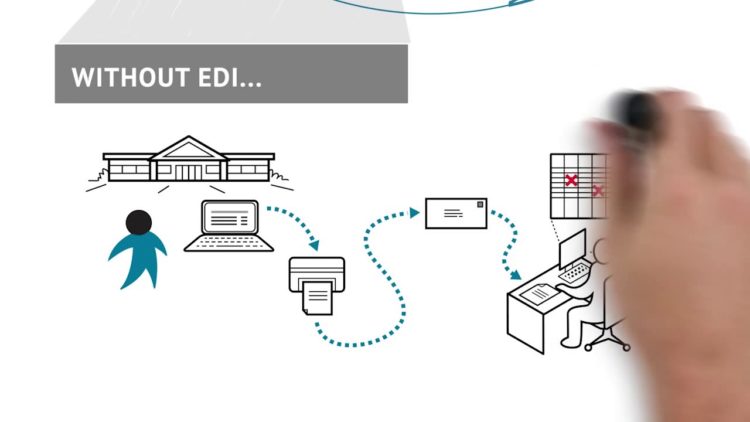
Electronic Data Exchange, otherwise known as EDI, refers to the electronic exchange of invoices, delivery notes, orders and all the other types of documents related to business. The exchange occurs automatically between two parties. EDI is a mix of internationally accepted standards for business documentation, protocols that refer to exchange or communication and electronic processes. The structured data exchange must be secure and simple. If you are still not sure how it works, keep reading and we will provide an in-depth guide.
The benefits of EDI

More and more businesses accept all the innovative methods that can make the work simpler and more secure. When it comes to automating business processes, using EDI is highly recommended because it is very efficient and fast, but also because the chance of errors occurring is significantly reduced. The transmission time is faster. Businesses also care very much about cost-effectiveness, so it is important to mention that the transfer costs are significantly lower when compared to the paper.
Automating all the processes and integrating data means also that there will be no repeated entries or there will be significantly less, which is also huge progress. Just a while ago, there was no way to store all the info in one database, which increased the number of stored papers and data enormously. With the progress of technology, we get a chance to improve many areas of work and the data integration and electronic data exchange may be the most important areas that make the work much easier.
In addition, the document flow in the paper form gets significantly reduced and the work duplication occurs less. What is also very important is that the lead times get reduced and the time gets saved along the process, which means that productivity gets significantly increased. When it comes to the control, making decisions and planning, EDI can enable a better overview of stock, better management of cash, but also with significant improvement of productivity analysis.
EDI functioning

Companies exchange messages using the business document standard established between them. This process has 3 steps. The first step is receiving messages through the SAP System. At this point, the messages are in an international format. After that, the conversion occurs – the messages convert from the international format to the message standard. After that, the communication is enabled through the communication protocol established between parties. The reversed process occurs on the other side when the message is converted to the international format and then transferred to the indented party.
If you are wondering why it is necessary to do this, the simplest answer would be to enable direct communication that is fast and secure, particularly because there is a large data amount. The EDI software has 3 main components: ERP connector, convertor, and the communication adapter. ERP connector is crucial for receiving and delivering messages in an international format. EDI Converter converts international format to the form of messages necessary by utilizing unique mapping.
The communication adapter serves to deliver the message to the other party that needs to receive it. It is important to stress that there are 2 components of EDI software. It is the main link that serves to connect two business partners and deliver the wanted message. The data exchange can be done via a point-on-point or mailbox system.
A point-to-point connection is ideal for transferring huge data loads. The two factors that impact the process of choosing a suitable transmission are the data volume and transmission frequency. On the other hand, a mailbox system refers to the electronic mailbox. The main benefit of a mailbox system is that business partners don’t need to be on the lookout constantly about the data, which enables independent communication to your partners. It is just important to have an established connection to the mailbox.
The types of EDI

Depending on the requirements of the company, there can be an in-house operation, cloud service or WebEDI. The companies that choose to have in-house operation have EDI software in their data center. The support and operation are also done by the company or outsourced. The main benefit of choosing this option is that the company does not depend on external partners. In case the company needs to protect its data privacy, so this is the main option.
When it comes to EDI as a Cloud Service, the company chooses to outsource the IT operations to the outside party. Platforms, software, and data get outsourced to the cloud provider. This option is most suitable for mid-size companies because having in-house EDI is too challenging for them. Having an EDI cloud service is more cost-effective for companies that don’t have large incomes. Cloud service is the perfect solution in cases when there is a staff shortage or a dependence on the specific employees and when there are innovative solutions planned. Also, when there are too many operational requirements that cannot be fulfilled. When there is a need for connecting a great number of parties or processes, Cloud Solution is a perfect answer.
It is important to say that operating EDI requires some knowledge and the companies that don’t have huge message volumes simply can be very inexperienced in that area. In this case, exchanging data via WebEDI is the ideal solution. It enables the company to communicate with other parties by using the internet to send and receive messages.
As you can see, it is truly a magnificent way that can help you improve your overall efficiency. Make sure you discuss all your requirements with the company that will take care of this for you and find the best solution for your company. Also, keep in mind that your staff may need a little training at first, but after the initial period is done you will be sure that all the processes are well implemented and fully functioning. Provide as much support as you can to your employees throughout the initial process.











